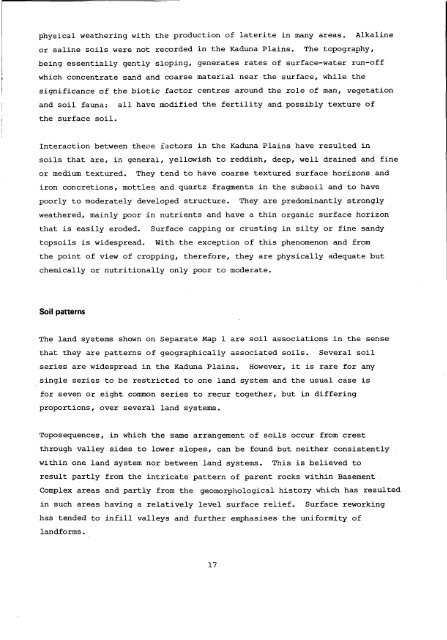Land resources of central Nigeria Agricultural development ...
Land resources of central Nigeria Agricultural development ...
Land resources of central Nigeria Agricultural development ...
You also want an ePaper? Increase the reach of your titles
YUMPU automatically turns print PDFs into web optimized ePapers that Google loves.
physical weathering with the production <strong>of</strong> laterite in many areas. Alkaline<br />
or saline soils were not recorded in the Kaduna Plains. The topography,<br />
being essentially gently sloping, generates rates <strong>of</strong> surface-water run-<strong>of</strong>f<br />
which concentrate sand and coarse material near the surface, while the<br />
significance <strong>of</strong> the biotic factor centres around the role <strong>of</strong> man, vegetation<br />
and soil fauna: all have modified the fertility and possibly texture <strong>of</strong><br />
the surface soil.<br />
Interaction between these factors in the Kaduna Plains have resulted in<br />
soils that are, in general, yellowish to reddish, deep, well drained and fine<br />
or medium textured. They tend to have coarse textured surface horizons and<br />
iron concretions, mottles and quartz fragments in the subsoil and to have<br />
poorly to moderately developed structure. They are predominantly strongly<br />
weathered, mainly poor in nutrients and have a thin organic surface horizon<br />
that is easily eroded. Surface capping or crusting in silty or fine sandy<br />
topsoils is widespread. With the exception <strong>of</strong> this phenomenon and from<br />
the point <strong>of</strong> view <strong>of</strong> cropping, therefore, they are physically adequate but<br />
chemically or nutritionally only poor to moderate.<br />
Soil patterns<br />
The land systems shown on Separate Map 1 are soil associations in the sense<br />
that they are patterns <strong>of</strong> geographically associated soils. Several soil<br />
series are widespread in the Kaduna Plains. However, it is rare for any<br />
single series to be restricted to one land system and the usual case is<br />
for seven or eight common series to recur together, but in differing<br />
proportions, over several land systems.<br />
Toposequences, in which the same arrangement <strong>of</strong> soils occur from crest<br />
through valley sides to lower slopes, can be found but neither consistently<br />
within one land system nor between land systems. This is believed to<br />
result partly from the intricate pattern <strong>of</strong> parent rocks within Basement<br />
Complex areas and partly from the geomorphological history which has resulted<br />
in such areas having a relatively level surface relief. Surface reworking<br />
has tended to infill valleys and further emphasises the uniformity <strong>of</strong><br />
landforms.<br />
17

















